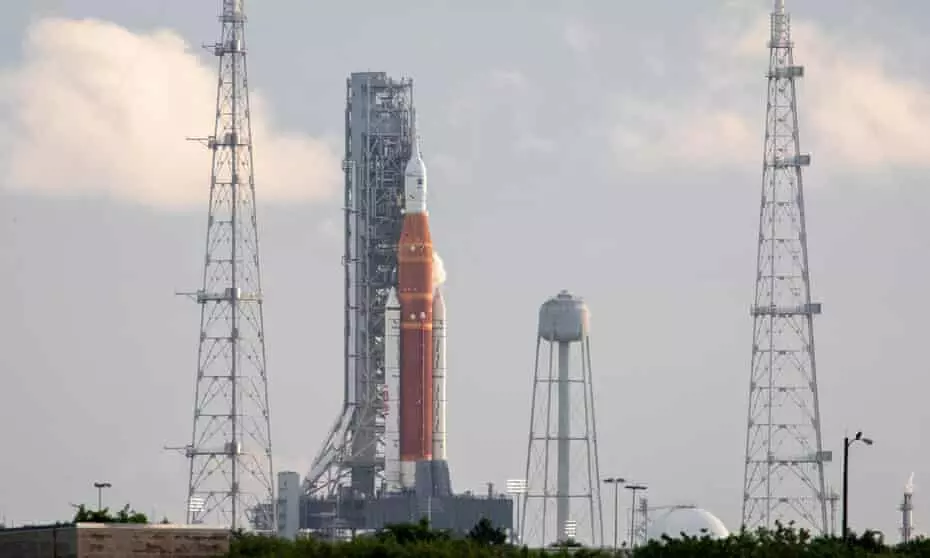
NASA cancels launch of Artemis 1 moon mission due to engine issue
text_fieldsAfter halting NASA's Monday liftoff of Artemis 1 late in the countdown due to an issue relating to "engine bleed," the agency is deferring a decision on the time of its next launch attempt for the rocket which is the US space agency's first human-rated moon rocket in 50 years.
During the overnight loading of 2.76 million litres (730,000 gallons) of liquid hydrogen and oxygen fuel required to launch the spacecraft on its 1.3 million miles, 42-day journey to the far side of the moon and back, engineers at NASA's launch complex in Cape Canaveral, Florida, discovered the issue with one of the four core-stage engines of the Space Launch System (SLS) rocket.
The two-hour launch window opened at 8:33 a.m. (1:33 p.m. BST) on Monday, but they were unable to locate a fix in time. As a result, they were debugging the problem to determine readiness for the next opportunity, which was on Friday, September 2.
"Friday is definitely in play. We just need a little bit of time to look at the data, but the team is setting up for a 96-hour recycle," Mike Sarafin, NASA's Artemis mission manager, told a lunchtime press conference.
"We're going to play all nine innings. We're not giving up yet."
No decision could be made, according to Sarafin, until mission managers completed a readiness review starting on Tuesday afternoon. He added that he didn't think the engine itself was the problem, but rather the bleed system that "conditions" the engine with cryogenic propellant and modifies its temperature for launch.
"The team … also saw an issue with a vent valve at the inner tank, so the combination of not being able to get the engine three chilled down and then the vent valve issue caused us to pause today, and we felt like we needed a little more time," he said.
Sarafin noted that the launch could also have not occurred due to adverse weather at launchpad 39B at the Kennedy Space Center throughout the Monday window.
Prior to humanity's anticipated return to the moon for the first time in a half-century, the unmanned Artemis voyage is a critical test mission intended to evaluate the capabilities of the SLS rocket and six-person Orion crew capsule.
Astronauts will be on board an intermediate test mission over the same journey 40,000 miles beyond the moon and back in 2024 if Artemis 1 is finally successful. A year or two later, the first moon landing since Apollo 17 in December 1972 would occur, and NASA said it would include the first woman to set foot on the moon.
A quarter of a million or more people descended on Florida's space coast on Monday to witness a historical event that has since been postponed to later this week, or even later in September or October if engineers are unable to rapidly identify and fix the engine bleed issue.
The Boeing-built rocket's issues initially surfaced during a "hot fire" test in January of last year, when the engines abruptly stopped running one minute into an eight-minute run. At that point, the project was already roughly three years late and $3 billion (£2.55 billion) over budget.
The Artemis mission, whose overall cost to the US taxpayer is expected to be $93 billion (£79 billion) by 2025 and whose longer-term objectives include sending the first humans to Mars in 15 to 20 years, is criticised as being unjustifiable, according to the Guardian.
However, Bill Nelson, the administrator of NASA and a former space shuttle astronaut, claimed that leaving new human footprints on the moon will serve a higher purpose than those made by the 12 men who participated in the Apollo programme over the course of six flights in a previous generation.
"We need to be on the moon for much longer periods of time than just landing like we used to, stayed a couple of days and left," Nelson told NBC's Meet the Press on Sunday. "This time we're going back, we're going to live there, we're going to learn there. We're going to develop new Xtechnologies, all of this so we can go to Mars with humans.
"All of this is to develop where we may be living on other worlds. They may be floating worlds, they may be the surface of Mars. But this is just part of our push outward, our quest to explore, to find out what's out there in this universe."
The International Space Station is located 250 miles above Earth, and private US space companies, including Elon Musk's SpaceX and Jeff Bezos' Blue Origin, have already flown there or are planning to do so. NASA's shuttle programme, which was retired in 2011, only allowed crewed missions to lower Earth orbit.
NASA's Artemis mission, which is the agency's first deep-space exploration effort in decades, mainly depends on independent contractors and international partners.
Boeing is the company that develops and produces SLS. Lockheed Martin was the driving force behind the Orion crew capsule. And the European Space Agency provides the service module, the spacecraft's engine for its trip to the moon after the potent solid rocket boosters and SLS core stage have lifted it out of the gravitational pull of the Earth.
The ESM will propel Orion farther away from Earth than any human-rated spacecraft has ever flown, while also supplying it with electricity, water, oxygen, and nitrogen, as well as maintaining the capsule's trajectory and ideal temperature before it separates and burns up in the atmosphere during its return to Earth.












